Original link: https://shyrz.me/news-17-be-a-nobody/

22 · 07 · 03 Issue No. 17

Everyone, Xia An! The weather is hot, pay attention to heatstroke prevention. Thanks to the friends who rewarded in the last issue.
In this issue, “Can a company “own” a color? Compiles decades of cases where companies have registered trademarks for brand colors and analyzes their significance; “Is Slavery Good for the American Economy?” “Combined with historical perspectives, it comparatively analyzes the impact of slavery in the South and industrialization in the North on the American economy at that time, and expands the geographical perspective; Confident Writings unearths previously undisclosed Bruce Lee manuscripts and introduces some of his ideas.
Hope that inspires.
Can a company “own” a color?
The Hustle June 25, 2022 article by Zachary Crockett.

One summer day in 2019, Daniel Schreiber opened his mailbox to find a threatening letter from one of the world’s largest telecommunications companies.
In the letter, Deutsche Telekom (T-Mobile’s parent company) accused Schreiber’s small insurance startup Lemonade of trademark infringement. Schreiber was confused: He didn’t use the T-Mobile name. He didn’t misappropriate the company’s logo or slogan. Heck, he’s not even in the cell phone business.
But as he read on, he realized his “crime” was using magenta .
In recent years, companies like T-Mobile have achieved what was once thought to be legally impossible: They have successfully trademarked personal colors.
When a color becomes synonymous with a brand—think a robin egg blue jewelry box, a brown delivery truck, or orange scissors—a company can claim some form of “ownership” over it.
But how could a company possibly invoke a color? How does this exclusivity affect its competitors?
A colorful history
Under the umbrella of intellectual property law, the 3 most common applications are trademarks, copyrights and patents.
While companies typically file all of these, they use the mark to (fairly freely) protect anything integral to their brand. According to legal principles , this may be “any word, name, symbol or device” that “(used to) identify and distinguish” the company’s goods or services from its competitors.
When a trademark is granted, it gives companies the exclusive right to use that intellectual property in their respective industries.
 Note: Although the trademark is indefinite, it still needs to be renewed every 10 years. (Zachary Crockett/The Hustle)
Note: Although the trademark is indefinite, it still needs to be renewed every 10 years. (Zachary Crockett/The Hustle)
For many years, the color itself did not serve as a trademark.
Although companies have successfully trademarked color combinations (eg, Campbell’s soup label), the USPTO rejected attempts to trademark a single color. For example, John Deere does not allow green claims in the farm equipment industry.
Scholars have made a number of arguments against the issuance of monochromatic trademarks:
- Color Exhaustion Theory : There are only about1,867 solid Pantone colors; if brands all claimed a color, we would eventually run out.
- Color Difference Theory: It is difficult for consumers to determine the difference between slight shades of a brand’s claimed color.
But everything changed when these things showed up:
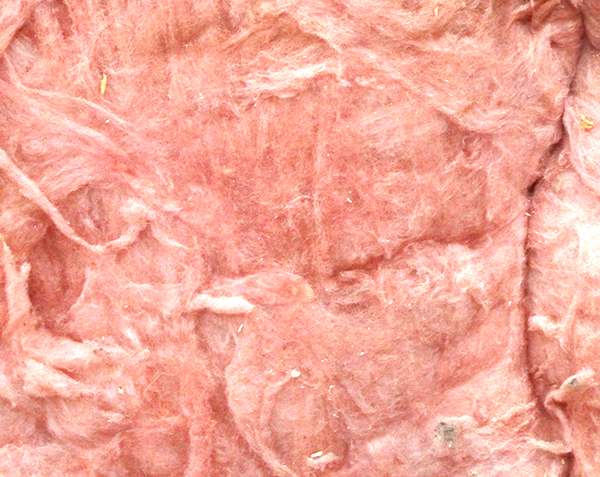 Owens-Corning fiberglass insulation in its signature pink tint (Pixabay)
Owens-Corning fiberglass insulation in its signature pink tint (Pixabay)
This is a piece of fiberglass insulation (the stuff behind our walls) from a company called Owens-Corning.
In the late 1950s , Owens-Corning faced stiff competition from other fiberglass insulation companies. At the time, all products were the same “natural tan ” shade; to differentiate, Owens-Corning decided to infuse their products with dye.
For the next 30 years, the company used its distinctive pink insulation as a marketing tool: adopting the “think pink” slogan, using the Pink Panther as a mascot, and spending tens of millions of dollars promoting the color .
In 1985 , after five years of litigation, Owens-Corning became the first company in American history to successfully register a color.
A decade later, a second company, Qualitex, went all the way to the Supreme Court to defend the trademark for its iconic green-gold dry cleaning pads. The court ruled that color can indeed be used to identify a brand—doing so opens the floodgates for companies to apply for their own color trademarks.
What does it take to register a trademark for a color?
In the decades since the Supreme Court case, many companies have successfully registered single-color trademarks.
Tiffany & Co. trademarked its famous blue color in 1998 – the same year UPS trademarked its ” Pullman Brown “, 3M secured its signature canary yellow for its Post-it notes, and Deutsche Telekom protected T- Mobile is famous for magenta , and Fiskars has an orange scissor handle.
There are even some you wouldn’t expect: The Wiffle Ball, Inc. has a yellow logo for bats, while the estate of the late musician Prince currently has a pending purple logo.
These trademarks are also not proprietary to the business. Both the University of Texas at Austin ( Pantone 159 ) and the University of North Carolina at Chapel Hill ( Pantone 542 ) have protected their school colors.
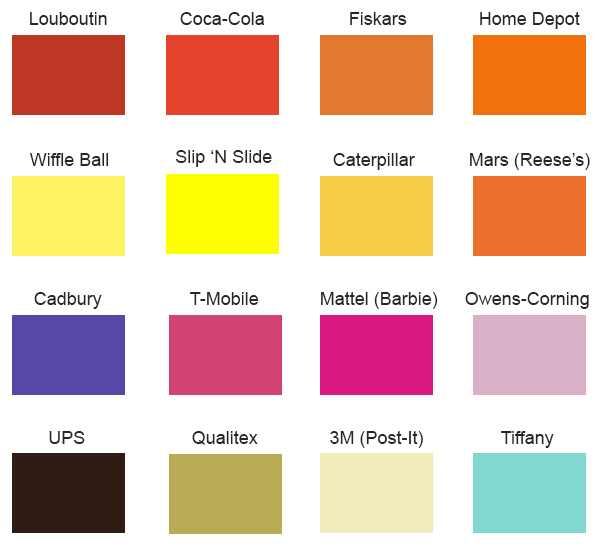 Some of these companies, like Cadbury, have already lost their color marks in legal battles (Zachary Crockett/The Hustle)
Some of these companies, like Cadbury, have already lost their color marks in legal battles (Zachary Crockett/The Hustle)
Certain colors of many brand marks may appear with the logo (for example, red and yellow for McDonald’s, or blue for Facebook). But these companies did something different and rarer: They trademarked word color swatches.
“Usually a company does so when their business model is somehow dependent on a particular color,” said Jeffrey Samuels, professor emeritus at the University of Akron Law School. “It will trademark a color to prevent other companies from using it. ”
An important distinction, Samuels added, is that a company that owns a color trademark only “owns” the color associated with a particular good or service.
Take Paisley Park Enterprises’ purple logo, for example. The logo image is only purple – no text, no logo, no other form of branding. If approved, it would give them the right to use purple in live music venues . They claim that purple alone is enough to identify their brand.
 Trademark filed by Paisley Park Enterprises to secure shades of purple (Pantone “Love Symbol #2”) for musical performances (Justia)
Trademark filed by Paisley Park Enterprises to secure shades of purple (Pantone “Love Symbol #2”) for musical performances (Justia)
In order to successfully obtain such a trademark, a company must demonstrate a single color:
- Achieving a ” secondary sense ” (differentiating the product from its competitors and identifying the company as the ultimate source of the product)
- Does not disadvantage competitors by affecting cost or quality
- no functional purpose
That last point means “a color has to be very random” to be trademarked: it cannot be essential to the production of the product, nor can it be used for any practical purpose, says intellectual property attorney Robert Zelnick.
At times, proving this can be extremely challenging.
General Mills, for example, twice failed to obtain a trademark for the yellow color on its Cheerios boxes, citing that the color was not synonymous with the brand because too many other cereal companies used it in their brands.
Pepto-Bismol’s attempt to trademark pink was thwarted because the court considered the color’s “healing” effect on customers to be “functional.”
color wars
As Lemonade’s CEO has learned, companies that acquire color trademarks often go to great lengths to enforce them in court — and competitors often challenge their monopoly on certain colors.
 Top: Former T-Mobile CEO John Legere went out of his way to adopt the brand’s magenta hue (Twitter); Bottom: Color chart from the T-Mobile/Lemonade event showing the difference in color the brand claims to “own”
Top: Former T-Mobile CEO John Legere went out of his way to adopt the brand’s magenta hue (Twitter); Bottom: Color chart from the T-Mobile/Lemonade event showing the difference in color the brand claims to “own”
Over the years, these controversial trademarks have sparked dozens of lawsuits related to color “ownership”:
- In 2002, Mattel filed a lawsuit against MCA Records, which included allowing the band Aqua to use its signature pink color on the album cover of the single “Barbie Girl.” The judge advised both sides to “calm down”.
- In 2010, the Hershey Company sued Mars for using orange on the packaging of its peanut butter candy bars . The lawsuit was later dropped.
- In 2011, Louboutin won the case against Yves Saint Laurent for infringing its trademark red sole.
- In 2015, tool maker DeWalt won a $54 million judgment against a competitor that copied its black and yellow color , but it was later dismissed on appeal.
But one company has been protecting its color trademarks in particular.
T-Mobile’s parent company, Deutsche Telekom AG, has spent at least 12 years trying to stop rivals (some big, some small) from using magenta .
While its trademark only covers a specific variant of the color ( Pantone Rhodamine U ), the company has expanded the definition of magenta to include a variety of peripheral shades. Thanks to Deutsche Telekom’s involvement in numerous projects, it is also able to defend its trademarks in industries outside of telecommunications, from fashion to healthcare .
In 2008, it sued rival European wireless carrier Telia . A few months later, it asked tech media Engadget to remove magenta from its mobile logo. In 2014, a judge ruled that AT&T subsidiary Aio Wireless couldn’t use magenta because it would confuse T-Mobile customers.
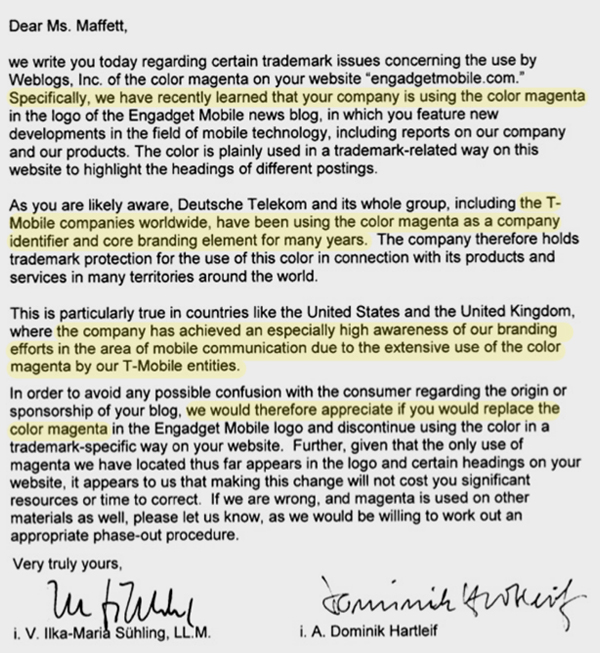 Letter from T-Mobile parent company to Engadget asking the blog to stop using magenta in its logo (Engadget)
Letter from T-Mobile parent company to Engadget asking the blog to stop using magenta in its logo (Engadget)
Its latest victim, Lemonade, has complied with T-Mobile’s demands by changing the colors of its marketing materials in Germany, where Deutsche Telekom is based. The company also filed a motion in Europe to “invalidate Deutsche Telekom’s magenta trademark.”
Making such a change can be costly — especially for large companies that spend tens of millions of dollars on marketing and branding strategies.
But legal fees also increase for companies that are constantly going after color trademark infringements, which raises a question.
Is it worth all the effort to trademark a color?
When a company applies for a black and white trademark — like a simple logo — by default, the mark is protected by virtually all color variations. No one can take a McDonald’s red and yellow logo , turn it purple and green, and claim it’s theirs.
So why bother to trademark a color when a brand might already have so many other protections?
“You’ll only see brands do this when color is critical to the brand, sales, or how the product is marketed,” said intellectual property attorney Zelnick.
 Of all trademarks (including logos), blue is the color of choice (Zachary Crockett/The Hustle)
Of all trademarks (including logos), blue is the color of choice (Zachary Crockett/The Hustle)
Most marketers are aware of the impact of color on consumer behavior. Surveys and research show that:
- 62%-90% of consumers’ initial judgment about a product is based on color.
- 52% of consumers say packaging color is an indicator of quality.
- Color can increase brand recognition by 80% .
So if you want to turn your entire brand into one solid color, try your luck. Just don’t choose magenta .
Was slavery good for the American economy?
Medium blog post by Erik Engheim for June 20, 2022.
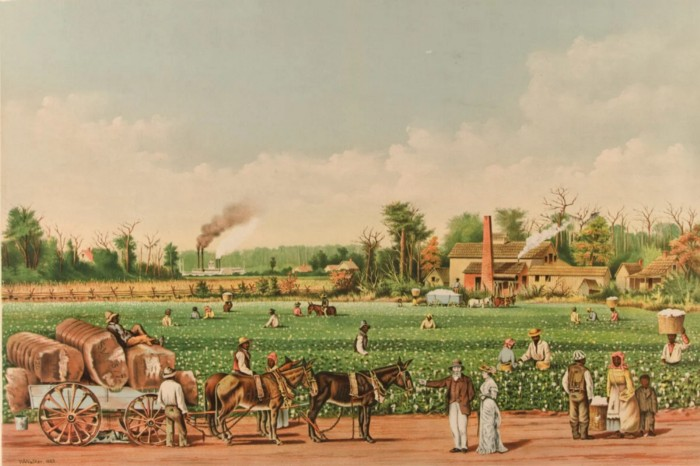
When I wrote about why the Nordic countries still lag the US in GDP per capita, I pointed to slavery as a factor. If you’re curious about this claim, read my article discussing the question in more detail: If Social Democracy is so great, why is America richer than the Nordic countries?
What I want to discuss in this story are some interesting rebuttals to this claim that I got in the comments. Historian David Wilson makes a good point:
Take a look at Charleston, South Carolina today. The city looks like it did in the 18th and 19th centuries. No skyscrapers…hardly any tall buildings. This major city of the Deep South’s slave trade and birthplace of the Confederacy is an economically backward place even today.
What should we conclude from this? Rather than slavery giving the United States an edge over the Nordic countries, is slavery actually holding back the United States? I think the answer to this question is quite complicated. I do believe that slavery contributed to the structural problems that the American South is still grappling with. Even the United States itself is grappling with issues such as racism and the conflict between African-Americans and the white majority population.
However, I am reluctant to admit that slavery did not benefit the American economy as a whole. To explain why, I’ll quote some of the views on slavery by economist Adam Smith in his 1776 book The Wealth of Nations, and explain why industrialization in hot regions was generally problematic. If you look at world history, the American South is pretty much the only region that industrialized lately. In fact, this is a very common pattern.
Did slavery hinder the establishment of Southern commerce?
Historian David Wilson argues that slavery made it difficult to establish a business in the South compared to the North.
For white freedmen, it made no sense to conduct any business in the South that might compete with slave labor because the slave economy would drive down the cost of goods compared to the North. The reason northern workers opposed the extension of slavery to these territories was not a moral issue, but the knowledge that slavery would depress everyone’s wages.
I do not rule out that northern workers feared competition from slaves, but that did not mean slaves could compete with free men. This statement may seem strange. How can someone with a salary be cheaper than someone without a salary? However, slaves were not free. They need accommodation, clothing and food. I would like to say something I once read about doing business in China. Today, Chinese workers earn much higher hourly wages than workers in many other poor countries, so why do companies still set up operations in China? This is because Chinese workers are highly productive. They have a lot of output for every hour they work. It doesn’t matter if you pay him half the hourly rate if he is only half as productive.
Therefore, the value of goods and services produced by slaves per hour must exceed that of free men. Economist Adam Smith wrote in Chapter 2 of Volume III of The Wealth of Nations that this is often not the case:
I believe that the experience of all times and countries shows that the work done by slaves, although it may appear to cost them nothing but their subsistence, is in the end the most important thing.
A man who cannot acquire any property has no profit but to eat as much as possible and labor as little as possible. Any work he does, other than enough to buy his own subsistence, can only be exploited by violence and not by any benefit of his own.
In ancient Italy, when corn fell under the control of slaves, how degraded the cultivation of corn was and how unprofitable it was for the masters, both Pliny and Columera said.
To underscore how expensive slave labor was, Adam Smith pointed out that growing conventional crops such as grain was almost never done by slaves because slave labor could not compete with free men. Slavery was only possible with lucrative crops like tobacco, sugar, and cotton:
Growing sugar and tobacco could afford slave farming. In this day and age, the cultivation of corn seems impossible. In the British colonies, where maize was the main product, most of the work was done by free men.
To support his claim, he shows how his hypothesis accurately predicts the cultivation of various types of crops:
In any of our West Indies colonies, sugar plantations are generally far more profitable than any other plantation known in Europe or America. Tobacco plantations are less profitable than sugar, but better than corn, as we have seen. Both could afford slave farming, but more sugar than tobacco.
So, in our sugar colonies, the ratio of blacks to whites is much greater than in the tobacco colonies.
Adam Smith goes on to give many such examples. Today we also have the knowledge of Chinese history to learn from. A serf is a kind of slave. The serf system has developed in many agricultural societies in history, but not in China. Why is this? Writer Malcolm Gladwell addresses this issue in his book Living Out of the World.
Growing rice in paddy fields along terraces is quite complex and delicate work. Getting a slave to do the job efficiently has never worked. Slaves are not interested in the attention to detail needed to maximize yield because slaves do not benefit from their greater attention to detail. So the rulers of China gave up their enslavement of the peasants. Free farmers will always be more competitive than slaves.
I cover this topic in detail in this story. But slavery ended 160 years ago!
If slavery was so inefficient, why did it spread? There are several reasons. One of the reasons that Adam Smith pointed out is the human desire for status and power. Those who can command an army of slaves feel more empowered.
But another big reason I suspect is that cotton, sugar, and tobacco are often cultivated in climates that are too hot for people of European descent. While reading about slavery, I see many accounts of how Native Americans were used as slaves in the early days, but they died too quickly. So the brutal logic of the colonialists was to use African slaves as they proved to be more durable and able to survive the harsh conditions of growing sugar and cotton.
Was slavery bad for the economies of the southern states?
It is easy to conclude that slavery did not enrich the South, as we know that the American South has long been known as a poorer region. This is one of the points made by David Wilson.
Yes, agriculture was very important, but the economy of the free labor industrialized North was an order of magnitude larger than that of the South. There’s a reason the South’s economy only began to catch up with the North after the civil rights reforms of the 1960s.
Here I think it is very important to get the time frame right. One of the things I talked about in my article comparing the economic development of northern Europe and the United States is that the United States was so rich before industrialization, when agriculture dominated the economy. Before industrialization, the southern states were actually the richest in America, not the poorest. Here’s a quote from history.com that emphasizes the relative affluence of the South:
Slavery was lucrative, and the Mississippi Valley produced more millionaires per capita than anywhere else in the country.
The countries of the South are very superior compared to the rest of the world.
If the FRY were an independent country, it would be the fourth richest country in the world when the civil war began.
So the question is, if the South is so rich and prosperous, why are they falling behind the North? A key reason is that the South industrialized much later.
Why was the process of industrialization in the South late?
Historian David Wilson argues that slavery itself and the agricultural economy were the direct causes of the South’s backwardness. He pointed out that slavery was not a contributor to the U.S. economy, or at least did not explain why the U.S. had such a big economic lead over the Nordic countries.
Slavery left the South economically backward compared to the free laboring, industrialized North. It tethered the South to an agricultural economy, concentrated wealth in the hands of a tiny elite, and undermined economic growth elsewhere in the region.
I think Wilson makes a reasonable point, but I think there are many other possible explanations that must be considered. One of the topics I write about is how climate and geography affect economic development. My claim is that the geography and climate of the South may have been more important reasons for its failure to industrialize. If you want to learn more about this topic, here are some articles.
- Geography and Economics
- Why are cold countries richer than hot countries?
- Why did the UK industrialise in the first place ?
- Why didn’t China industrialize first?
The countries of the South are not a strange outlier in the history of industrialization. Advanced and mature countries, from China to Italy and Spain, failed to industrialize early. On the contrary, in the history of industrialization, almost all the leading countries were in the north, from the United Kingdom, Belgium, Germany, France and later the Nordic countries.
This is not pure accident. All early factories were powered by water. The mass production of iron was driven by water wheels, and the same applies to textile mills. Why do you think the Industrial Revolution was centered in Manchester in the north of England? This is because the city has many streams that are high enough to drive water wheels. In fact, there are hundreds of waterwheels in the area around Manchester, powering different machines.
People tend to think that the Industrial Revolution was all about the steam engine, but that was very late. The steam engine requires a lot of cheap steel, which is impossible to produce without mass production, while the waterwheel can.
The second important factor is having rivers and canals to transport large quantities of goods. Before steel was mass-produced cheaply, it was impossible to simply build massive railroad tracks and steam engines. Therefore, coal and iron ore had to be transported along canals and rivers.
But don’t the countries and regions of the South have rivers, canals and waterfalls? Yes, but little support for industrialization. You look further south and you have the rainy season and very uneven rainfall. In China, the amount of water in a river can fluctuate up to 80 times. This means you may find rivers and canals too low to deliver goods, or flooded.
What is the UK known for? Comics in the UK is a country where people carry umbrellas all the time because it rains all year round. That’s one reason why Britons flock to Spain for holidays whenever they get the chance. It also means that the UK has a very steady flow of water that can be used to transport and power machines all year round.
The conditions in the northern states are most similar. They have terrain and water flow to build water-powered mills. One of the more famous examples may be Lowell Mills in Waltham, Massachusetts.
We must also take into account that factory production was indoor work until the advent of electric fans and air conditioners that greatly favored cold climates. Humans are generally easier to deal with cold than heat. We could put on more clothes, or heat the room with coal or wood. If you work in a hot climate, you will suffer from heat stroke. The human body regulates through feelings of exhaustion, prompting you to stop working to prevent heat stroke and death. It’s not without reason that people often take naps in hot climates.
In fact, the southern states began to industrialize in the late 19th century, but railroads made it easier to move goods in bulk. The advent of electric fans in the 1880s made indoor work easier in hot climates.
Another point is that the backwardness of the American South may be exaggerated. One argument I’ve heard is that the South is just less populated. If you look at factories per capita, the South is not as far behind the North as it is often said.
Was slavery in the South good for the American economy?
I strongly believe that slavery was good for the American economy. My assumption is based on the fact that industrialization tends to depend on exports. Before and during industrialization, the South’s slave-based economy provided the bulk of America’s exports.
What you always read about the industrialization of emerging economies is the demand for foreign exchange. This was a major problem in my native Norway when industrial output kicked in after World War II. Exports provided important foreign exchange reserves, and they needed to import machinery to build factories. This is one of the reasons why we ration cars, telephones and many other imported products, because this will deplete foreign exchange reserves.
Even in the 19th century, Britain was an important exporter, providing Norway with machinery, tools and expertise, as was the case in many other countries, including the United States.
Let us also not forget that textile mills in the northern states require raw material inputs. If there is no cotton grown in the southern states, where will they get it? Therefore, it is difficult to see the industrialization of the North take off without cotton plantations in the South.
What I’m trying to say is that the U.S. has a special place in economic growth that few other countries can share. In the same country, you have the conditions to grow cotton, surplus grain to feed people, waters to build mills, and rich deposits of minerals like coal and iron. We can also add the vast reserves of oil that the United States was able to tap in 1859. As early as 1920, per capita oil production in the United States was 140 times higher than in Europe.
Slavery helped generate profits and foreign exchange for early industrialization and access to these abundant resources, which is why the United States was able to surpass almost every other country between 1700 and 1900.
Related Articles and Statements
This topic is something I could research more. For me, this article is part of a learning process. Participate in the debate on this topic, I think I can also learn new things and perspectives on this topic. Towards the end of the writing, I found this article:
This is a little different from my point of view. It correctly points out that the slave economy is a small part of overall U.S. GDP, which is a perfectly reasonable notion, but also misleading about its importance. For example, oil accounts for only 14% of Norway’s economy, but about 40-50% of Norway’s exports, which is less than the 19th century US slave-based economy contributed to exports.
Bruce Lee’s never-before-seen writings on willpower, emotion, reason, memory, imagination and self-confidence
The Marginalian August 1, 2016 article by Maria Popova.
Although Bruce Lee (November 27, 1940 – July 20, 1973) is best known for his storied legacy in martial arts and cinema, he was also one of the most underrated philosophers of the 20th century, in introducing the East to Western audiences Tradition has played an important role. He majored in philosophy in college, blending ancient ideas with his own unique ethos inspired by the intersection of the disciplines of physiology and psychology, most famously embodied in his water metaphor for resilience .
Early in his career, Bruce Lee was marginalized by Hollywood’s studio system, which operated under extreme racism and still used yellow-skinned white actors to create Asian characters based on flattened stereotypes. He’s been told over and over again that white audiences simply won’t accept an Asian star in a movie.
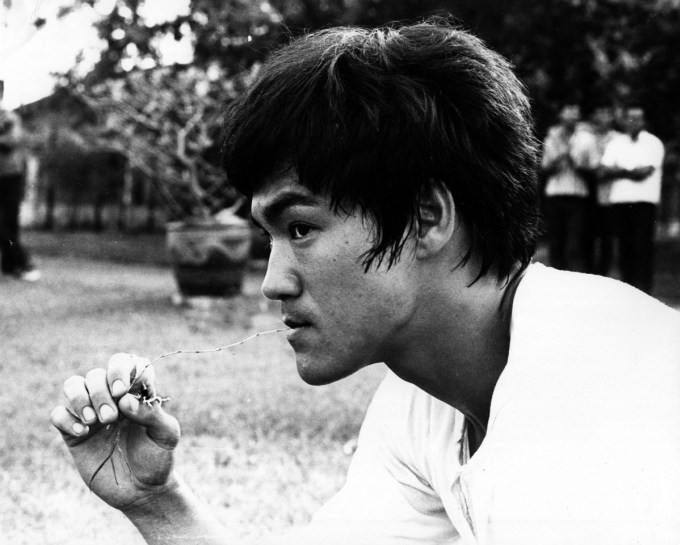
Even though he eventually broke through and was cast as the lead role, the studio still saw him as a tool man to entertain with his kung fu. When they tried to cut all philosophical elements from “Dragon and Tiger” because they wanted a vacuously entertaining action movie, Bruce Lee went on strike for two weeks, insisting that kung fu and philosophy were inextricably linked and that the two complemented each other. Hollywood eventually had to give in, and it was the philosophical aspect that made the film — just before Bruce Lee’s tragic death just before release — a cultural icon and beacon of racial empowerment associated with the Black Power movement, which was later picked up by the Library of Congress. Acquired as “culturally, historically and aesthetically significant” artefacts.
Bruce Lee believed that philosophy was inseparable from everyday life, just as he believed that mind and body were inseparable, the two poles of a battery were constantly charging each other. He documents his rigorous exercise program as well as the philosophical meditations that fill his life. Like Oliver Sacks with a notebook everywhere , Bruce Lee always carried a 2-by-3-inch handbook full of everything from training regimens to students’ phone numbers (including Chuck Noel’s). cadets like Rees and Steve McQueen) to poetry, assertions, and philosophical reflection. Even his handwriting, meticulous and uniform to fit within the dimensions of the handbook, exudes a strong sense of discipline and order.

But perhaps the most notable part of his journal — or the so-called day timer — is his assertion, reminiscent of what Nobel laureate Andre Gide wrote in his youthful diary The rules of conduct under the slogan, or the diary-style self-questioning of the artist Eugène Delacroix. In these notes to himself, Bruce Lee articulates his personal philosophy, specific to his own upbringing, but resonating with universally applicable insights into our shared psychology, behavior, and humanity.
With special permission from the Bruce Lee Legacy Fund , the following are pages from his 1968 handbook, written shortly before Bruce Lee’s 28th birthday, each page is transcribed below, from Napoleon Hill’s “Everyday Success Creed.” ” to begin, and Bruce Lee copied it into his notebook:

Willpower :-
Recognize that the power of will is the supreme court of all other branches of my mind, and when I need the urge to act for any purpose, I will exercise it daily; I will make it a habit to put my willpower into action at least once a day action.
Feelings : –
Realizing that my emotions are both positive and negative, I will develop daily habits that will encourage the development of positive emotions and help me turn negative emotions into some form of useful action.
Reason :-
Recognizing that my positive and negative emotions can be dangerous if not controlled and directed to desired goals, I will submit all my desires, goals, and purposes to my rational capacity, under whose guidance I will achieve expression.
Imagination :-
Recognizing the need for sound plans and ideas to achieve my aspirations, I will develop my imagination by calling on it every day to help me develop my plans.
Memory :-
Recognizing the value of alert memory, I would encourage me to be alert, paying attention to impressing clearly with all the thoughts I want to recall, and linking those thoughts to relevant themes that I may recall frequently.
Subconscious : –
Recognizing the influence of my subconscious mind on my willpower, I will carefully submit to it a clear and unambiguous picture of my clear life purpose and all the small goals that lead to my main goal, and I will here Before always keeping this picture repeating my subconscious every day.
Conscience :-
Recognizing that my emotions are often wronged by overzealousness and that my rational faculties are often deficient in the warm feeling necessary to enable me to combine justice with benevolence in my judgment, I will encourage my conscience to guide me in what is right, What is wrong, but I will never set aside the verdicts it makes, no matter what the cost of enforcing them.
When Bruce Lee came up with a particularly important idea, he would write it on the back of a plain 3-by-5-inch yellow notecard and sign it, like a will or a contract with himself. He often distills or reproduces the reflections originally recorded in his journal, and writes them down on note cards reserved only for his strongest convictions and deepest devotions.
These assertions are particularly noteworthy for their blend of ancient philosophical and spiritual traditions (especially Zen ideas of character, self, and self ), unreliable New Age magical thinking, and the habits of mind that contemporary psychology has proven fruitful – Reminder We, our personalities, are a mix of times and cultures, with their inherent knowledge and ignorance, and it is the way we combine the elements at our disposal that makes us.

You’ll never get more out of life than you expect. Focus on the things you want, not the things you don’t. The power to calmly observe what is going on around you makes a difference a) the world b) our response to it to be aware of our condition! Abandon and remove the inner obstacles from the inside out~~~ We first have to remove our attitude, not change the external conditions to see that there is no one to fight, there is just an illusion to see through, no one unless you allow it Can hurt you internally, psychologically, being a nobody
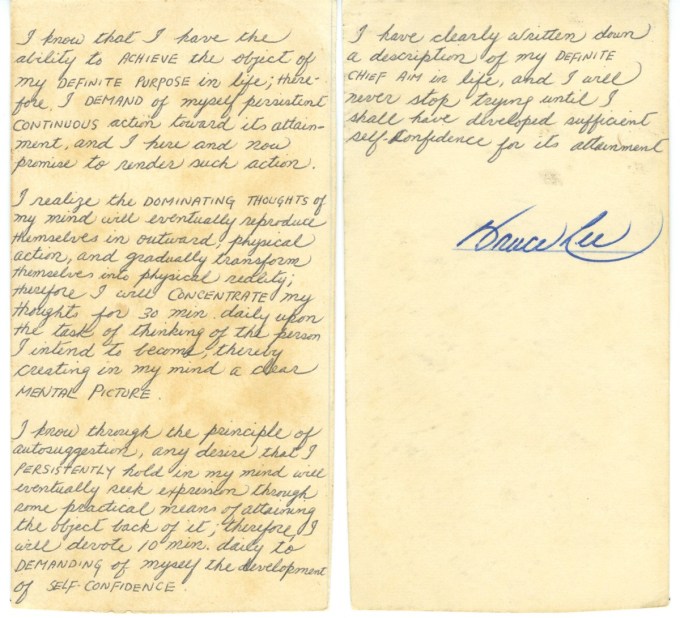
I know that I have the ability to achieve my life purpose; therefore, I require myself to take persistent, continual action to achieve it, and I promise to take that action here and now.
I realize that the dominant thoughts in my head will eventually reappear in external physical actions and gradually translate into physical reality; therefore, I will focus on thinking for 30 minutes a day about who I intend to be, thereby in my head Construct a clear mental picture.
I have learned from the principle of autosuggestion that any desire that I have been holding will eventually be expressed through some practical means to achieve the object behind it; therefore, I will devote 10 minutes a day to asking myself to increase my self-identity.
我已经清楚地写下了我人生中明确的主要目标的描述,并且我将永远不会停止尝试,直到我培养出足够的自信来实现它。
速览
- ?设计: iOS 应用程序图标简史
- ?游戏:译介丨Claire Morwood:给所有人的Bitsy 教程(2017)
- ?历史:微笑:一段历史
- ⌛效率:效率是敌人
- ?科学:安鲁效应或可证明量子引力
捐赠
?Shyrism.News 是一份甄选的时事通讯,两周一期,涵盖新奇趣闻、热点议题、前沿科技以及其他关于生活、关于未来的事物。以精心细致的筛选对抗外强中干的算法,以热情洋溢的文字中和冷漠呆板的代码。
如果您觉得「Shyrism.News」有价值,请支持和分享给你的朋友或社交网络。
感谢打赏的朋友,请务必备注称呼或邮箱,以免清理账户时丢失数据。
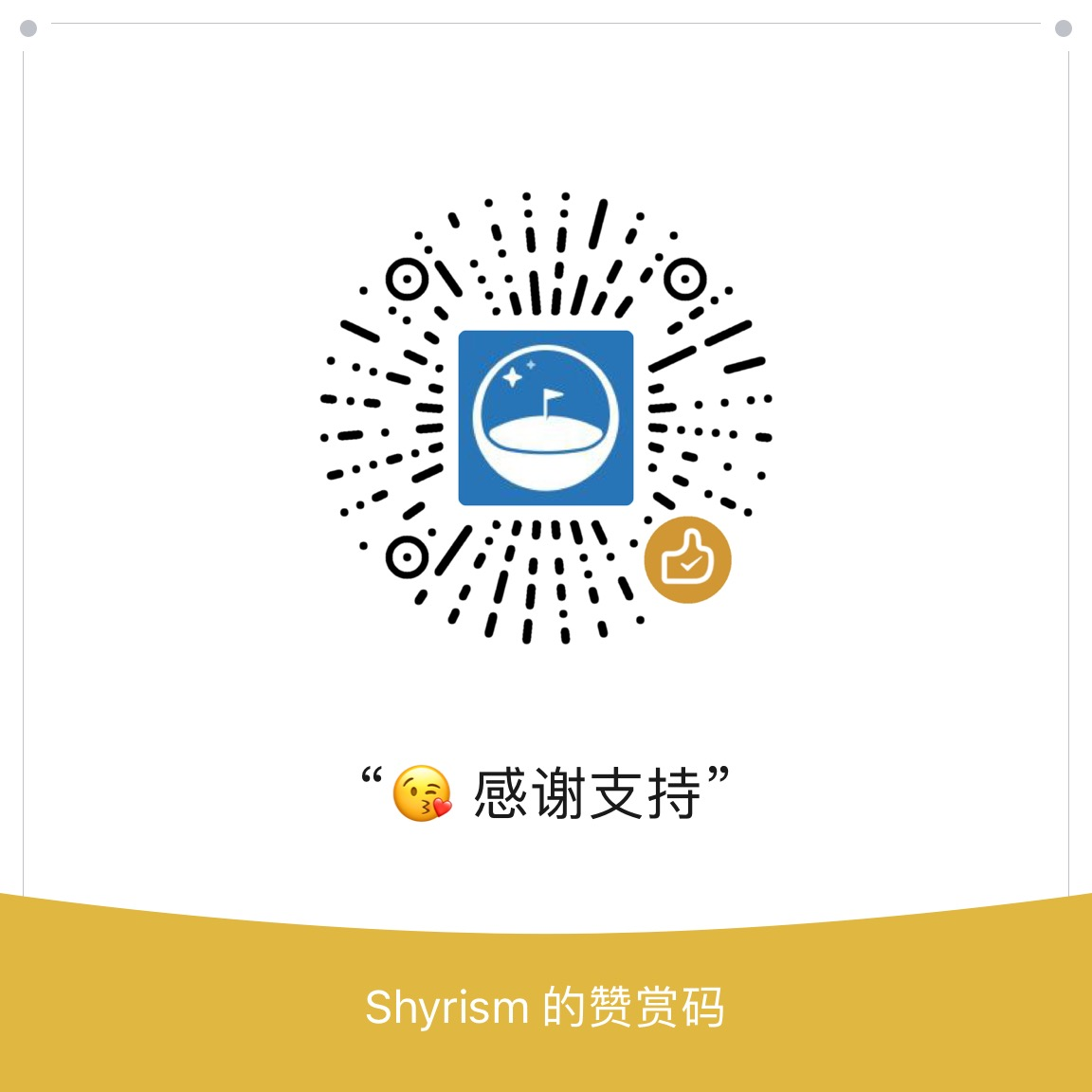
本文转自: https://shyrz.me/news-17-be-a-nobody/
This site is for inclusion only, and the copyright belongs to the original author.